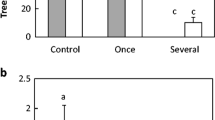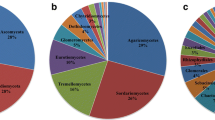Abstract
Endophytic fungal communities in leaves of deciduous trees usually undergo pronounced seasonal changes. We hypothesised that such compositional shifts are predominantly caused by annuality of the leaves and therefore less pronounced in fungi colonising the perennial substrates bark and corticolous lichens. To test this hypothesis, thalli of the foliose lichen-forming fungal species Xanthoria parietina and Physconia distorta, along with the adjacent bark, were sampled during spring and autumn at two sides of a single tree in southern Germany. Analysis of clone libraries by restriction fragment length polymorphism (RFLP) revealed 588 singleton and 221 non-singleton RFLP-types of non-lichenised fungi. The communities differed significantly between host lichen species. Season and exposure had only a significant impact when the two factors were combined in the analysis. Accordingly, bark- and/or the lichen-associated fungal communities change throughout the year’s course, a finding that rejects the initial hypothesis. This survey revealed valuable information for future broad-based studies, by indicating that a relatively high diversity of non-lichenised fungi is associated with corticolous lichen thalli and the adjacent bark. Furthermore, the structure of non-lichenised fungal assemblages associated with corticolous lichen communities obviously depends at least on the following factors: ‘lichen species’, ‘exposure’, and ‘season’.
Similar content being viewed by others
References
Amend AS, Seifert KA, Bruns TD (2010) Quantifying microbial communities with 454 pyrosequencing: does read abundance count? Mol Ecol 19:5555–5565. doi:10.1111/j.1365-294X.2010.04898.x
Barkman JJ (1958) Phytosociology and ecology of cryptogamic epiphytes: including a taxonomic survey and description of their vegetation units in Europe. Van Gorcum & Comp. N.V., Assen
Ellis MB, Ellis JP (1997) Microfungi on land plants: an identification handbook. Richmond Pub, Slough
Girlanda M, Isocrono D, Bianco C, Luppi-Mosca AM (1997) Two foliose lichens as microfungal ecological niches. Mycologia 89:531–536. doi:10.2307/3760987
Kowalski T, Kehr RD (1992) Endophytic fungal colonization of branch bases in several forest tree species. Sydowia 44:137–168
Peršoh D (2013) Factors shaping community structure of endophytic fungi—evidence from the Pinus-Viscum-system. Fungal Divers 60:55–69. doi:10.1007/s13225-013-0225-x
Peršoh D, Rambold G (2012) Lichen-associated fungi of the Letharietum vulpinae. Mycol Prog 11:753–760. doi:10.1007/s11557-011-0786-6
Peršoh D, Melcher M, Flessa F, Rambold G (2010) First fungal community analyses of endophytic ascomycetes associated with Viscum album ssp. austriacum and its host Pinus sylvestris. Fungal Biol 114:585–596. doi:10.1016/j.funbio.2010.04.009
Peršoh D, Segert J, Zigan A, Rambold G (2013) Fungal community composition shifts along a leaf degradation gradient in a European beech forest. Plant Soil 362:175–186. doi:10.1007/s11104-012-1271-y
Rambold G, Triebel D (1992) The Inter-Lecanoralean associations. Biblioth Lichenol 48:1–201
Scholtysik A, Unterseher M, Otto P, Wirth C (2013) Spatio-temporal dynamics of endophyte diversity in the canopy of European ash (Fraxinus excelsior). Mycol Prog 12:291–304. doi:10.1007/s11557-012-0835-9
Stone JK, Polishook JD, White JF (2004) Endophytic fungi. In: Mueller G, Bills G, Foster M (eds) Measuring and monitoring biodiversity of fungi. Inventory and monitoring methods. Elsevier Academic Press, Bosten, pp 241–270
Sun X, Ding Q, Hyde KD, Guo LD (2012) Community structure and preference of endophytic fungi of three woody plants in a mixed forest. Fungal Ecol 5:624–632. doi:10.1016/j.funeco.2012.04.001
U’Ren J, Lutzoni F, Miadlikowska J, Arnold AE (2010) Community analysis reveals close affinities between endophytic and endolichenic fungi in mosses and lichens. Microb Ecol 60:340–353. doi:10.1007/s00248-010-9698-2
Unterseher M, Reiher A, Finstermeier K, Otto P, Morawetz W (2007) Species richness and distribution patterns of leaf-inhabiting endophytic fungi in a temperate forest canopy. Mycol Prog 6:201–212. doi:10.1007/s11557-007-0541-1
Unterseher M, Jumpponen ARI, Öpik M, Tedersoo L, Moora M, Dormann CF, Schnittler M (2011) Species abundance distributions and richness estimations in fungal metagenomics—lessons learned from community ecology. Mol Ecol 20:275–285. doi:10.1111/j.1365-294X.2010.04948.x
Wearn JA, Sutton BC, Morley NJ, Gange AC (2012) Species and organ specificity of fungal endophytes in herbaceous grassland plants. J Ecol 100:1085–1092. doi:10.1111/j.1365-2745.2012.01997.x
Weig A, Peršoh D, Werner S, Betzlbacher A, Rambold G (2013) Diagnostic assessment of mycodiversity in environmental samples by fungal ITS1 rDNA length polymorphism. Mycol Prog. doi:10.1007/s11557-012-0883-1
Werner S, Peršoh D, Rambold, G (2012) Basidiobolus haptosporus is frequently associated with the gamasid mite Leptogamasus obesus. Fungal Biol 116:90–97. doi:10.1007/s11557-012-0883-1
White TJ, Bruns T, Lee S, Taylor J (1990) Amplification and direct sequencing of fungal ribosomal RNA genes for phylogenetics. In: Innis M, Gelfand D, Shinsky J, White T (eds) PCR Protocols: A Guide to Methods and Applications. Academic Press, pp 315–322
Acknowledgments
We thank Hubertus Löffler (München) for providing permission to access the investigated tree.
Author information
Authors and Affiliations
Corresponding author
Rights and permissions
About this article
Cite this article
Beck, A., Peršoh, D. & Rambold, G. First evidence for seasonal fluctuations in lichen- and bark-colonising fungal communities. Folia Microbiol 59, 155–157 (2014). https://doi.org/10.1007/s12223-013-0278-y
Received:
Accepted:
Published:
Issue Date:
DOI: https://doi.org/10.1007/s12223-013-0278-y




